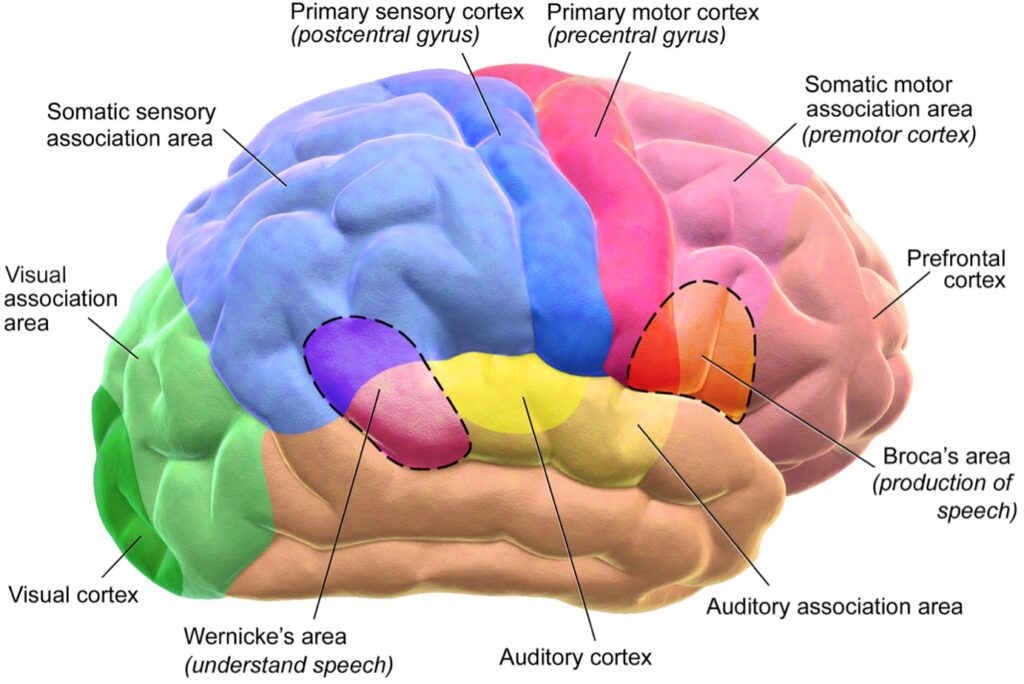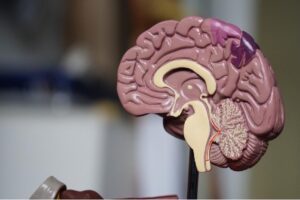
Figure 1: The human brain and its various functional regions. Researchers have shown that a select group of individuals – supertaskers – activate the prefrontal cortex (shown above) and the anterior cingulate cortex (not shown) at high levels to maintain their goals during multitasking
Source: Wikimedia Commons
Understanding the human brain is arguably one of the most fundamental goals in science, not only for neuroscientists but for scientists in other fields as well, including computer scientists and linguists. Studying the brain helps computer scientists better model Artificial Neural Networks (ANNs), algorithms that mimic human intelligence at the cognitive level by replicating the role performed by neurons in a machine-like setting. ANNs can be used for security, underlying advanced face and speech recognition (Krogh, 2008). Scientists in the 20th century reached a consensus that at least basic sensory and motor functions reside in specialized brain regions, providing some evidence for the functional specialization of the brain (Kanwisher, 2010). So, in the context of such a profound behavior like multitasking, it would be beneficial to experimentally determine which parts of the brain is responsible for this trait. Doing this would take us a step closer to understanding the mechanisms that support maximized productivity.
In 2014, Medeiros-Ward, Jason Watson and David Strayer, psychologists from the University of Utah, sought to investigate the neural mechanisms that underlie efficient multitasking. They investigated which part of the brain is responsible for efficient multitasking, specifically for individuals they called “supertaskers” (Medeiros-Ward et al., 2014).
According to the American Psychological Association (APA), multitasking refers to the simultaneous undertaking of two tasks (APA, 2006). Multitasking is a common trait among human beings, and it is viewed as a time-saving tool to being more productive. While multitasking can indeed “save time” for some of us, it is usually accompanied by contact switching costs – the loss in productivity (doing poorly in either task in terms of completion time) incurred while attempting two tasks concurrently. Rogers and Monsell from the University of Cambridge showed that switching between simple cognitive tasks results in high error rates for most individuals (Rogers & Monsell 1995; APA, 2006).
However, in 2010, Watson and Strayer showed that despite there being a perceivable loss in performance during dual-task paradigms, there are individuals, aptly named “supertaskers”, who show no discernible loss in performance during multitasking (Watson & Strayer, 2010). One might wonder why supertaskers are not more prevalent, if the super-tasking trait is so potentially helpful. Watson and Strayer offer an evolutionary explanation: this trait may not yet have propagated through the population, and as such, we might not directly notice many of these supertaskers in our midst. Their experiment, while providing conclusive evidence of the existence of supertaskers, provides no answer to the question: “What is the neuronal basis for efficient multitasking?” Answering this question, in the context of neurobiology or neuroimaging research, might at least explain what makes these supertaskers able to supertask.
While no mention of supertaskers occurred before Watson and Strayer’s study on the identification of supertaskers, various cognitive scientists embarked on studies to prove the neurological cause of what makes high performers perform better than the average crowd. One such popular study was conducted by Jaeggi et al., from the University of Bern in Switzerland. In their study, Jaeggi et al., sought to answer the following question: “What differentiates high performers from low performers at the neuronal basis?”
The researchers performed fMRI tests on individuals as they did a cognitively demanding task: the renowned n-back task, famous for revealing individual differences in cognitive domains such as working memory and attention. fMRI measures the changes in blood flow during brain activity []. The n-back task involves presenting stimuli to subjects (usually olfactory and visual stimuli). The participants are required to monitor the stimuli and give a response when they notice a similarity in the presentation of the stimuli, that is, they are required to give a response (usually by pressing a button) when they notice that a certain stimulus was presented n-integers ago. For instance, if the sequence of presented letters was HETH, then the participants are required to give a response when they see the second H since it was presented 2 letters ago.
Jaeggi and her team evaluated 22 areas of interest in the participants’ brains when they performed the challenging n-back task. Generally, they found that the brains of high performers “keep cool” during cognitively demanding tasks; that is, few regions in the brains of high performers are employed when carrying out cognitively demanding tasks. They also identified specific regions of the brain as important for mediating difficult tasks: an increase in activation was observed in the left prefrontal cortex (LFC), for example. With the Prefrontal Cortex (PFC) playing an important role in mediating executive functions in humans such as working memory (small amount of information that can be held in mind and used in the execution of cognitive tasks), it should come as no surprise that high performers recruit this specific part of their brains (Lara & Wallis, 2015). Albeit paradoxical, these results could be explained by the fact that high performers use the required parts of their brain (their lateral prefrontal areas) much more efficiently when compared to their middle and low performer counterparts by recruiting as little of them as possible (Jaeggi et al., 2007).
Medeiros-Ward, Watson and Strayer investigated this effect further by employing a dual n-back task that presented olfactory and visual stimuli to supertaskers and comparing them against lower-performing controls. They found that the “cooling effect” applied to supertaskers as well. Additionally, they found that the Anterior Cingulate Cortex (ACC) was also recruited when performing the rigorous dual n-back task (Medeiros-Ward et al., 2014). The ACC is known for mediating emotions, and this could explain why supertaskers also “keep cool” while engaging in cognitively demanding tasks, essentially avoiding all distractions and detecting errors that conflict with the task at hand (Stevens et al., 2011). Moreover, Jean-Claude Dreher, from French National Centre for Scientific Research, and his team found that damage to the frontopolar cortex, which is part of the larger prefrontal cortex, causes a decrease in multitasking performance, suggesting that this region too is essential (Dreher et al., 2008).
In the grand scheme of things, the studies done by Medeiros-Ward et al. and Jaeggi et al. help shed light on the individual neuronal differences between common low performers and supertaskers. Specifically, the studies support the functional organization of the brain in controlling human behavior. Still, many questions arise as to how these supertaskers “keep cool.” It would be valuable to determine if average individuals could leverage the FPC-ACC system in conducting not only dual tasks but also single difficult tasks. Hopefully, ANNs could be modelled to mimic this “super tasking effect.” and understanding the few supertaskers available would mean better-modelled ANNs. As the work environment becomes more and more demanding, and electronic distractions abound, a better capacity to multitask would be of immense value to individuals in all lines of work.
References
(2006, March 20). Multitasking: Switching costs [..Org]. Https://Www.Apa.Org. https://www.apa.org/research/action/multitask
Dreher, J.-C., Koechlin, E., Tierney, M., & Grafman, J. (2008). Damage to the Fronto-Polar Cortex Is Associated with Impaired Multitasking. PLOS ONE, 3(9), e3227. https://doi.org/10.1371/journal.pone.0003227
Jaeggi, S. M., Buschkuehl, M., Etienne, A., Ozdoba, C., Perrig, W. J., & Nirkko, A. C. (2007). On how high performers keep cool brains in situations of cognitive overload. Cognitive, Affective, & Behavioral Neuroscience, 7(2), 75–89. https://doi.org/10.3758/CABN.7.2.75
Kanwisher, N. (2010). Functional specificity in the human brain: A window into the functional architecture of the mind | EndNote Click. Proceedings of the National
Related Posts
Prescribing Ecotherapy: A Powerful Health Intervention
This publication is in proud partnership with Project UNITY’s Catalyst Academy 2023...
Read MoreAlleviating Vaccine Hesitancy: The Path to a Safer Future
The human mind is constantly working on the fly, adapting...
Read MoreThe Public Health Crisis of Alzheimer’s Disease in African American and Hispanic Populations
This publication is in proud partnership with Project UNITY’s Catalyst...
Read MoreCollins Kariuki



